#pseudophryne corroboree
Text
Creature Awaits #196
Each week I plan to feature an amazing creature, admiring God's fantastic artistry. Hopefully it’ll brighten someone’s day to see something new and interesting if they haven’t seen it before. : )

(Beautiful still taken by the photographers at the Australian Alps National Parks (CC BY-NC-ND 2.0 (upscaled to fit format)))
The Corroboree Frogs
Scientific Name: Pseudophryne pengilleyi (The Northern Corroboree Frog) and Pseudophryne corroboree (The Southern Corroboree Frog)
Region: Two very tiny, high altitude ranges in southeastern Australia
Size: Only about 1"-1 1/6" (~2.5cm-3cm) long
Interesting Notes: Interestingly, unlike most other known toxic frogs, this species creates its own poisonous alkaloid, called pseudo-phrynamine, entirely within its own body's chemistry as opposed to ingesting toxins from plants, etc. Though they are considered critically endangered, due primarily to habitat loss via bushfire and fungal infection by Chytrids, thankfully, conservation efforts are underway to preserve these two beautiful species.
#creatureawaits#Corroboree Frogs#Pseudophryne pengilleyi#Pseudophryne corroboree#Northern Corroboree Frog#Southern Corroboree Frog#beautiful frogs#toxic frogs#frogs of Australia#Australian wildlife
0 notes
Text
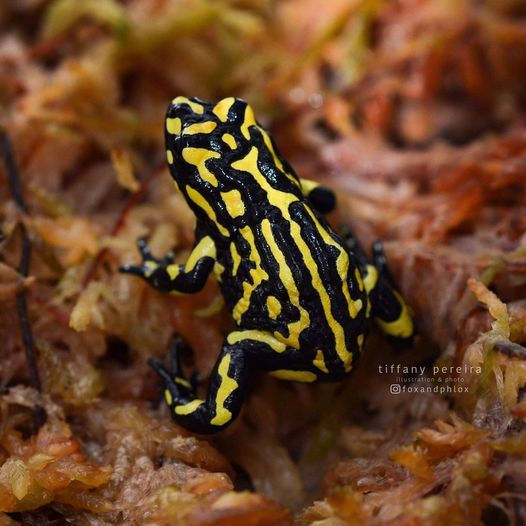
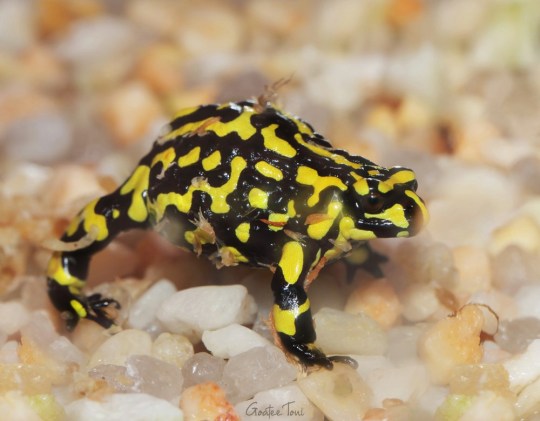
Southern Corroboree Frog (Pseudophryne corroboree), family Myobatrachidae, found in far SE Australia
CRITICALLY ENDANGERED.
Poisonous.
Endangered due to climate change, Chytrid fungus, introduced species, and brushfires. There are fewer than 180 individuals left in the wild.
photographs by Tiffany Pereira and Toni Kingston
247 notes
·
View notes
Text

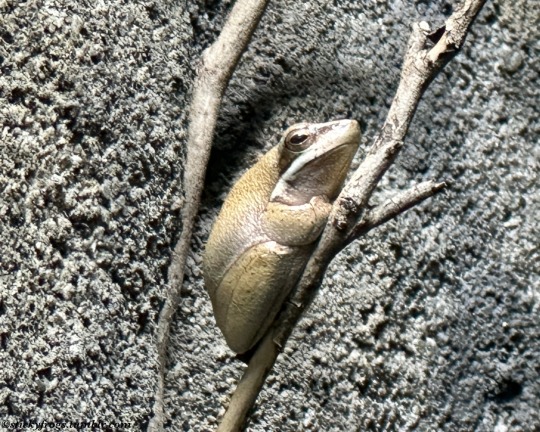
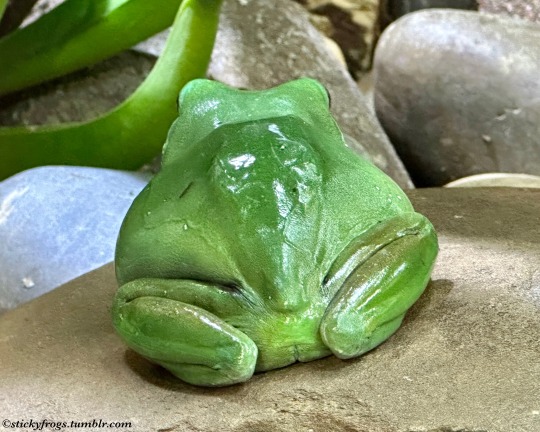

We also met some Adhesive Blobs (Litoria gracilenta), a Tiny Staring Friend (Litoria fallax), a Green Bottom, and a Southern Corroboree Frog (Pseudophryne corroboree) wearing her Total Party Onesie!
#Graceful Tree Frog#Eastern Dwarf Tree Frog#White’s Tree Frog#southern corroboree frog#australian frogs#melbourne zoo
345 notes
·
View notes
Note
What are some vulnerable/threatened/endangered species that you think are cool? (This can include both animals and plants)
There's a few, so I'm only doing critically endangered Australian species.
The south coast underground orchid, Rhizanthella johnstonii, is native to Western Australia and one of the weirdest plansts I've ever seen. Their mature population is estimated at a max of 49, but the population is stable.

The Lord Howe Island stick insect, Dryococelus australis, was thought to be extinct since 1920 before it was rediscovered in 2001. It's considered the rarest insect in the world, and while once found throughout Lord Howe Island, it's now only found on the islet of Bell's Pyramid. They're being killed by invasive black rat population on the island, who eat the adults and young, and the estimated mature population on the island is a max 35 individuals. Efforts are being made to eradicate the rats from the island, and reintroduce mature breeding adults, since luckily this is a species that thrives in captivity. Their primary threat is invasive species.

The Wyong Midge orchid, Genoplesium insigne, is native to the Central Coast of New South Wales. Their population is decreasing, and their estimated mature max population is 19. Their primary threats are invasive species particularly predation by rabbits, habitat disturbances, and illegal collecting.

The green sawfish, Pristis zijsron, is found the northern oceanic and intertidal waters of Australia. They used to be very prevalent in the waters north of Kakadu. The IUCN doesn't list their estimated population, but it is known that it's decreasing. Their primary threat is overfishing, as their fins are used for shark fin soup, their snouts are considered souvenirs, and because their meat is often desired for use in traditional Asian medicine, specifically Chinese. Their snouts also make them get caught in fishing nets often, and they're often killed being being brought on boats because of the danger their snouts pose to humans. They're also threatened by habitat loss. This is a species culturally important to many Aborigine mobs, and a species that's often considered sacred.

The southern corroboree frog, Pseudophryne corroboree, is a frog native to the Southern Tablelands of NSW. For a frog they're unique--most frogs obtain their poisons from animals they eat, but corroboree frogs produce their own poison. Their primary threats are habitat destruction, feral animals, chrytrid ("frogkiller") funguses, and bushfires. Their max mature population is 50, and their population is decreasing.

The orange-bellied parrot, Neophema chrysogaster, is native to Tasmania, its only known breeding location. This is one of the three known migrating parrot species. Their maximum mature population is 25. Their primary threats are competition with invasive species, predation by invasive species, habitat loss, and disease.
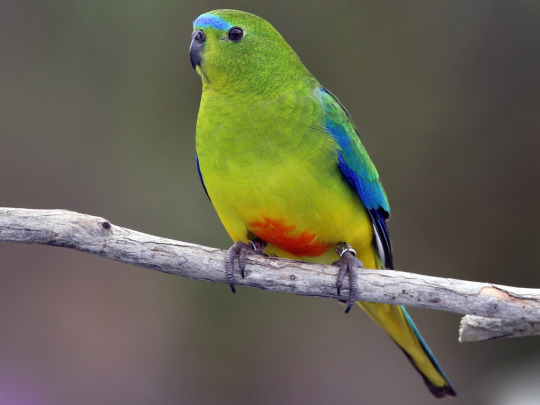
11 notes
·
View notes
Text
These little guys are super rare. They live within the Kosciuszko National Park in Australia and there's only 50 to 200 of them left in the whole world because their populations are threatened by a type of fungus as well as loss of habitat caused by fires. Even though their future does not look very bright, conservation efforts are strong. Just earlier this year, 100 frogs were released into the wild as part of a conservation programme.
The Corroboree frog is poisonous, and uniquely so, they produce their own poisonous alkaloids rather than get it from their food.

Their reproduction is quite strange, too. They take 4 years to reach sexual maturity and their eggs take 4 to 6 months to hatch, then it might take another 6 to 8 months for tadpoles to develop. They are also known to hibernate in the winter.
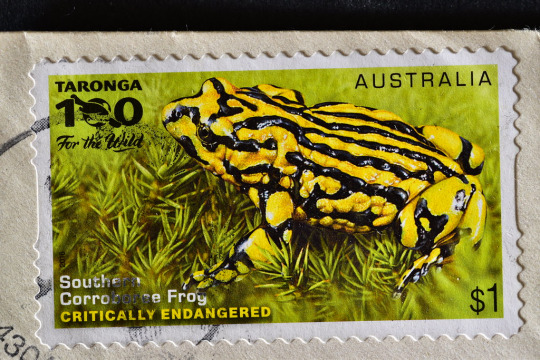
I actually learned about these frogs because just like the Magnificent Tree frog, they also got their own stamp by the Australian government.
Photo source: Michael McFadden
Stamp designers: Owen Bell, Sonia Young
#frog#amphibians#herpetology#biology#nature#science#corroboree frog#southern corroboree frog#australia
2 notes
·
View notes
Text

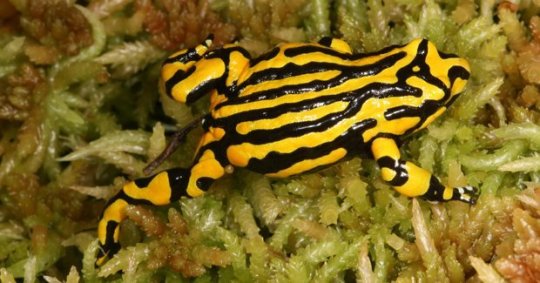
Monte Iberia Dwarf Frog: This is the smallest frog in the Northern hemisphere and the third smallest frog in the world! Found only in a small region of Cuba, they are critically endangered due to deforestation and mining operations in their limited habitat. They are one of two species in their genus to be toxic, likely gaining their poisonous skin from the mites they eat, and the bright lines on their back seem to mimic another toxic genus, Phyllobates. They seem to lay a single egg which directly develops into a froglet, although evidence to conclusively determine this is lacking. Contrary to most other tiny frogs, their call is relatively low-frequency, at just under 6 kHz.
Corroboroee Frog: These two Australian species are the only frogs to synthesize their own poison! Other poisonous species such as poison darts get theirs from the insects they eat, but corroboree frogs make it all by themselves. Males mate with multiple females from a nest they dig next to their breeding pool, and the female only lays 16-38 eggs per clutch. These eggs develop into embryos then wait to hatch until the nest floods with autumn rains. P. pengilleyi reach sexual maturity at different times depending on their altitude – higher altitude populations tend to take 4 years, while lower altitude ones only take 2. P. corroboree, on the other hand, take 3-4 years. Pictured is P. corroboree, the Southern Corroboree frog.
1 note
·
View note
Text

today’s funky frog of the day is: pseudophryne corroboree! commonly known as the southern coroboree frog, they are one of australia’s most endangered species, only found in kosciuszko national park. these frogs are able to produce their own toxin, an alkaloid called pseudophrynamine, instead of obtaining it by diet like most poisonous frogs. because of this, they have no natural predators, but they are threatened by climate change and habitat disturbance. there are reportedly less than 200 of these frogs left.
560 notes
·
View notes
Photo
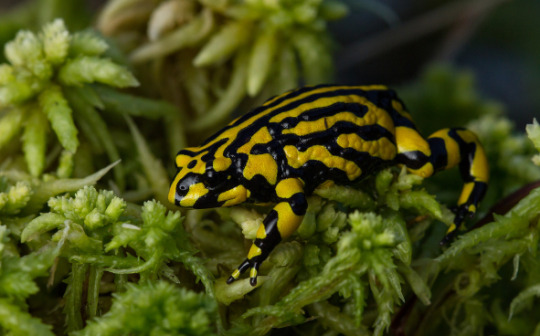
Southern Corroboree Frog
Pseudophryne corroboree
#pseudophryne corroboree#pseudophryne#corroboree frog#southern corroboree frog#frog#amphibian#amphibia#herp#herpetology#anura#myobatrachidae#ground frog#poisonous#zoology#animal#animalia#wildlife#wildlife biology#endangered#endangered species#endangered wildlife#critically endangered
364 notes
·
View notes
Photo
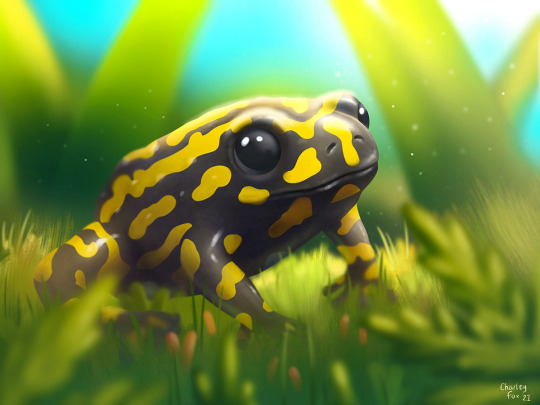
Happy World Frog Day! The critically endangered Corroboree Frog (Pseudophryne corroboree) with less than 50 mature frogs in the wild.
#Corroboree Frog#Frogs#WorldFrogDay#Amphibian#Australian Animals#Animal Art#Animal Painting#Nature#CFArt
22 notes
·
View notes
Note
What are your favorite frogs?
Well there’s the Red-crowned toadlet (Pseudophryne australis). I have a soft spot for them because they’re found only within the Sydney Basin area and I’ve worked with them personally.
They are classified as vulnerable under the IUCN Red List due to their occurrence being less than 20,000km2 wide and the servery fragmented distribution, resulting in a number of declining subpopulations.

Another native australian frog species from the genus;Pseudophryne. The southern corroboree frog (Pseudophryne corroboree).
They are a critically endangered frog species as listed under the IUCN Red List due to a population loss of about 80% due to chytridiomycosis.
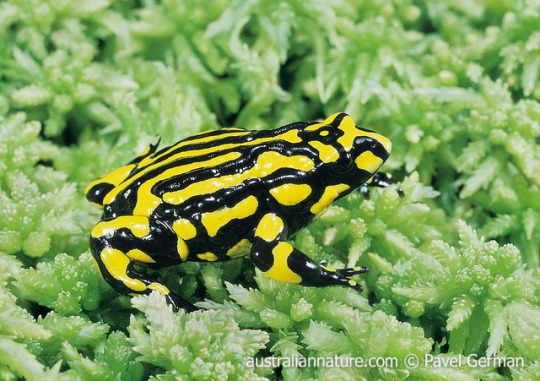
The Hairy frog (Trichobatrachus robustus) is an interesting species due to it’s unique defense mechanism, that has only been observed in this animal.
When threaten the frog will break the toes in it’s feet that will then break through the sink of the toes, acting as claws. The bone will retract and heal on it’s own. Hence why it’s sometimes referred to as the Wolverine frog.

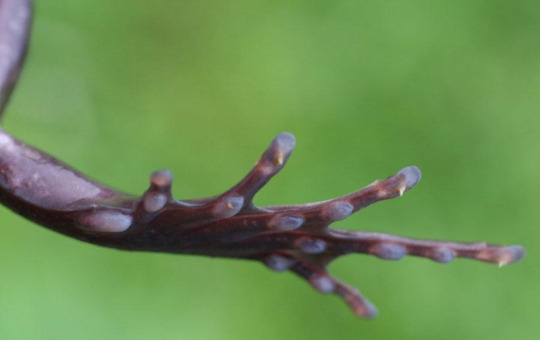
Also a shout out to the family Centrolenidae or the glass frogs. Called such because the skin on their ventral side of the frogs are so translucent you can see their organs.
Like this species below Hyalinobatrachium yaku

153 notes
·
View notes
Photo

New species of frogs discovered in Australia.
Hoser, R. T. 2020.
3 new tribes, 3 new subtribes, 5 new genera, 3 new subgenera, 39 new species and 11 new subspecies of mainly small ground-dwelling frogs from Australia.
LSIDurn:lsid:zoobank.org:pub:7AD890BA-A71D-44EE-8172-A1323BBAB7A3
Raymond t. Hoser
LSIDurn:lsid:zoobank.org:author:F9D74EB5-CFB5-49A0-8C7C-9F993B8504AE
488 Park Road, Park Orchards, Victoria, 3134, Australia.
Phone: +61 3 9812 3322 Fax: 9812 3355 E-mail: snakeman (at) snakeman.com.au
Received 15 September 2020, Accepted 28 September 2020, Published 10 October 2020.
ABSTRACT
An ongoing audit of Australian frogs, relying on morphological and molecular studies has identified a number of divergent lineages, including hitherto unnamed forms.
These most recent results are published in similar format to earlier cited papers of Hoser (2016a, 2016b, 2016c, 2019a, 2020a, 2020b, 2020c, 2020e and 2020f) that named frog taxa.
Adopting the taxonomy and nomenclature of Anstis (2013) and Cogger (2014) as the prevailing usage, the following taxonomic changes are made:
The genus Philoria Spencer, 1901 is split three ways with one new genus being erected.
The putative species Philoria loveridgei Parker, 1940, herein placed in a new genus is also split five ways, with four new species formally named for the first time.
The genus Pseudophryne Fitzinger, 1843 is split six ways using available names for two other groups and erecting genera for three other clades. Several new species within Pseudophryne sensu lato from four genera are also formally named.
The putative genera Crinia Tschudi, 1838 and Ranidella Girard, 1853 are rearranged as a single genus and split into six subgenera, with two groups formally named as new subgenera for the first time. New species within Crinia are also formally named.
The genus Geocrinia Blake, 1973 as currently recognized is formally split into two with the second genus formally named for the first time as Wellingtondella gen. nov., with a type species of Crinia rosea Harrison, 1927. Hesperocrinia Wells and Wellington, 1985, type species: Crinia leai Fletcher, 1898 is resurrected as a subgenus within Geocrinia, but in a totally different concept to that originally conceived by Wells and Wellington (1985).
Two new species within subgenus Hesperocrinia and three new subspecies within Geocrinia are also formally named.
The putative species Paracrinia haswelli (Fletcher, 1894) is split into three well defined species on the basis of allopatry and morphological divergence, two formally named for the first time.
The until now monotypic genus Metacrinia Parker, 1940, with the type species Pseudophryne nichollsi Harrison, 1927 is split into three species, each being morphologically and genetically divergent.
Uperoleia Gray, 1841 is divided into two genera while a further two subgenera within remaining Uperoleia are recognized. One subgenus Quasiuperoleia subgen. nov. is formally named for the first time, while available names, Hosmeria Wells and Wellington, 1985 (as a genus) and Prohartia Wells and Wellington, 1985 (as a subgenus) are resurrected. Two new species within genus Hosmeria, four new species and two new subspecies within subgenus Prohartia and four species and one subspecies in subgenus Uperoleia are formally named for the first time.
A subspecies of Barred River Frog, Mixophyes hoserae Hoser, 2020 (Oxyslopidae) from North-east Victoria and nearby New South Wales is formally named.
Myobatrachidae is also divided into four tribes and two further subtribes, all but the nominate tribe formally named for the first time.
Keywords: Frogs; Australia; New South Wales; Queensland; Western Australia; South Australia; Victoria; nomenclature; taxonomy; ICZN; Philoria; Kyarranus; Pseudophryne; Bufonella; Gradwellia; Kankanophryne; Crinia; Ranidella; Tylerdella; Metacrinia; Bryobatrachus; Geocrinia; Hesperocrinia; Uperoleia; Prohartia; Hosmeria; Mixophyes; Paracrinia; australis; bibroni; occidentalis; guentheri; robinsoni; douglasi; coriacea; corroboree; nichollsi; pengilleyi; dendyi; semimarmorata; haswelli; raveni; major; covacevichae; borealis; laevigata; lithomoda; new tribes; Myobatrachini; Uperoleiaini; Wellingtondellaini; Criniaini; new subtribes; Oxyphryneina; Spicospinaina; Paracriniaina; new genus; Bogophryne; Sloppophryne; Crottyphryne; Oxyphryne; Wellingtondella; new subgenus; Oxyodella; Lowingdella; Quasiuperoleia; new species; uterbog; duboisi; breonnataylorae; naomiosakaae; crotalusei; maxinehoserae; katrinahoserae; marcdorsei; hoserae; woolfi; euanedwardsi; scottgranti; jasminegrantae; martinekae; wellsi; wellingtoni; oxeyi; crottyi; sloppi; lowingae; stevebennetti; maateni; merceicai; brettbarnetti; brianbarnetti; lenhoseri; funki; bettyswileae; wilhelminahughesae; shuddafakup; shireensbogensis; jadeharrisae; keilleri; lowryi; shanescarffi; margweeksae; grantturneri; gedyei; rossignolii; new subspecies; oxyi; sadlieri; mensforthi; burrelli; kaputarensis; otwaysensis; grampiansensis; logani; maximus; divergans; jackyae.
#frog#frogs#amphibians#Australasia#Australia#Indonesia#Myobatrachidae#uterbog; duboisi; breonnataylorae; naomiosakaae; crotalusei; maxinehoserae; katrinahoserae; marcdorsei; hoserae; woolfi; euanedwardsi; scott
0 notes
Link
(adsbygoogle = window.adsbygoogle || []).push({});
Pseudophryne is a genus of small Myobatrachid frogs. All of these frogs are small terrestrial frogs, and as such, most species are commonly called toadlets (pseudo- meaning deceptive, phryne meaning toad). The genus comprises thirteen species, ten from eastern Australia, and three from Western Australia. Species within the Pseudophryne genus lay their eggs on moist ground. The tadpoles develop within the eggs, and once they reach hatching size, will become dormant. Once sufficient rain occurs to flush the eggs into a creek or river, the eggs will hatch and release tadpoles into the water. Many of the species within this genus have the ability to form hybrids.
Species
There are thirteen species from the Pseudophryne genus:
Common name Binomial name
Red-crowned Toadlet Pseudophryne australis (Gray, 1835)
Bibron’s Toadlet Pseudophryne bibronii Günther, 1859
Red-backed Toadlet Pseudophryne coriacea Keferstein, 1868
Corroboree Frog Pseudophryne corroborree Moore, 1953
Magnificent Brood Frog Pseudophryne covacevichae, Ingram and Corben, 1994
Southern Toadlet Pseudophryne dendyi Lucas, 1892
Douglas’ Toadlet Pseudophryne douglasi Main, 1964
Günther's Toadlet Pseudophryne guentheri Boulenger, 1882
Large Toadlet Pseudophryne major Parker, 1940
Orange-crowned Toadlet Pseudophryne occidentalis Parker, 1940
Northern Corroboree Frog Pseudophryne pengilleyi Wells and Wellington, 1985
Copper-backed brood frog Pseudophryne raveni Ingram and Corben, 1994
Southern Toadlet Pseudophryne semimarmorata Lucas, 1892
source - Wikipedia
if u like the post please like and shear (adsbygoogle = window.adsbygoogle || []).push({}); Because the study material is quite expensive, not all can buy it. The RBbox does the same small cache of the same information and study material to reach you for free. You also help in making this case successful by cooperating. You also have some information that you can send to others as a post or article. We will publish it with your name and picture. www.rbbox.in
0 notes
Text


Northern Corroboree Frog (Pseudophryne pengilleyi), family Myobtrachidae, found in SE Australia
CRITICALLY ENDANGERED.
Poisonous.
Though it's found in SE Australia, it is the more northerly species of the 2 Corroboree Frogs.
Found in wet grasslands, and surrounding moist forest habitats.
Endangered due to the Chytrid fungus, climate change, introduced species, and habitat degradation due to cattle grazing.
photographs by Damien Esquerré and Michael Swan
121 notes
·
View notes
Text

A beautiful corroboree frog in its enclosure at the Melbourne zoo. This is the southern species, Pseudophryne Corroboree.
0 notes
Text
Stamps of Australia: Endangered Animals (2016)
Seven special stamps by Australia Post representing endangered animals that are part of current zoo and/or other conservation programs in Australia. These animals are at risk of extinction and are classified as either Endangered or Critically Endangered according to Australian and international measures. Three animals are exotic and four are native.
The large definitive stamp, representing the Southern Corroboree Frog Pseudophryne corroboree, commemorates the centenary of Taronga Zoo in NSW, which has breeding programs for this rare frog. At just 2.5–3cm in length, this small, brightly coloured amphibian is one of the world’s rarest frogs.
The carnivorous Snow Leopard Panthera uncia syn. Uncia uncia is a large cat native to mountain ranges of central and south Asia at altitudes of 3,000 to 4,500 metres. These cats are rarely seen because they inhabit harsh terrain with an extreme climate and are distributed across a range of over two million square kilometres across 12 countries.
The Asian Elephant Elephas maximus used to roam over most of Asia, but is now restricted to just 15 per cent of its original range. The population has declined by at least 50 per cent over the last 60–75 years. The most recent estimate of the global population is 41,430.
The Western Lowland Gorilla Gorilla gorilla gorilla is a large primate native to the rainforests of central Africa, specifically in lowland forest and swamp forest from sea level to about 1,600 metres. Gorillas are mainly herbivorous. Their staple foods are pith, shoots and leaves. They also eat many species of fruit.
The short-necked freshwater Western Swamp Tortoise Pseudemydura umbrina is found only in two locations in a small area of the Swan Coastal Plain in Western Australia. It is Australia’s most endangered reptile and measures just 11 to 13cm from nose to tail.
One of the world’s rarest and most endangered species, the Orange-bellied Parrot Neophema chrysogaster, is on the brink of extinction. It is listed as Critically Endangered under the EPBC Act and on the IUCN Red List.
The Northern Quoll Dasyurus hallucatus is a small, omnivorous marsupial that once occurred across extensive areas of northern Australia. It has now contracted to only isolated populations.
Melbourne Zoo’s animals promote Endangered Wildlife stamps for Stamp Collecting Month. Seven special items released by Australia Post October 3, 2016
Stamps of Australia: Endangered Animals (2016) was originally published on Philatelic Database
0 notes
Photo

3 new tribes, 3 new subtribes, 5 new genera, 3 new subgenera, 39 new species and 11 new subspecies of mainly small ground-dwelling frogs from Australia.
LSIDurn:lsid:zoobank.org:pub:7AD890BA-A71D-44EE-8172-A1323BBAB7A3
Raymond t. Hoser
LSIDurn:lsid:zoobank.org:author:F9D74EB5-CFB5-49A0-8C7C-9F993B8504AE
488 Park Road, Park Orchards, Victoria, 3134, Australia.
Phone: +61 3 9812 3322 Fax: 9812 3355 E-mail: snakeman (at) snakeman.com.au
Received 15 September 2020, Accepted 28 September 2020, Published 10 October 2020.
ABSTRACT
An ongoing audit of Australian frogs, relying on morphological and molecular studies has identified a number of divergent lineages, including hitherto unnamed forms.
These most recent results are published in similar format to earlier cited papers of Hoser (2016a, 2016b, 2016c, 2019a, 2020a, 2020b, 2020c, 2020e and 2020f) that named frog taxa.
Adopting the taxonomy and nomenclature of Anstis (2013) and Cogger (2014) as the prevailing usage, the following taxonomic changes are made:
The genus Philoria Spencer, 1901 is split three ways with one new genus being erected.
The putative species Philoria loveridgei Parker, 1940, herein placed in a new genus is also split five ways, with four new species formally named for the first time.
The genus Pseudophryne Fitzinger, 1843 is split six ways using available names for two other groups and erecting genera for three other clades. Several new species within Pseudophryne sensu lato from four genera are also formally named.
The putative genera Crinia Tschudi, 1838 and Ranidella Girard, 1853 are rearranged as a single genus and split into six subgenera, with two groups formally named as new subgenera for the first time. New species within Crinia are also formally named.
The genus Geocrinia Blake, 1973 as currently recognized is formally split into two with the second genus formally named for the first time as Wellingtondella gen. nov., with a type species of Crinia rosea Harrison, 1927. Hesperocrinia Wells and Wellington, 1985, type species: Crinia leai Fletcher, 1898 is resurrected as a subgenus within Geocrinia, but in a totally different concept to that originally conceived by Wells and Wellington (1985).
Two new species within subgenus Hesperocrinia and three new subspecies within Geocrinia are also formally named.
The putative species Paracrinia haswelli (Fletcher, 1894) is split into three well defined species on the basis of allopatry and morphological divergence, two formally named for the first time.
The until now monotypic genus Metacrinia Parker, 1940, with the type species Pseudophryne nichollsi Harrison, 1927 is split into three species, each being morphologically and genetically divergent.
Uperoleia Gray, 1841 is divided into two genera while a further two subgenera within remaining Uperoleia are recognized. One subgenus Quasiuperoleia subgen. nov. is formally named for the first time, while available names, Hosmeria Wells and Wellington, 1985 (as a genus) and Prohartia Wells and Wellington, 1985 (as a subgenus) are resurrected. Two new species within genus Hosmeria, four new species and two new subspecies within subgenus Prohartia and four species and one subspecies in subgenus Uperoleia are formally named for the first time.
A subspecies of Barred River Frog, Mixophyes hoserae Hoser, 2020 (Oxyslopidae) from North-east Victoria and nearby New South Wales is formally named.
Myobatrachidae is also divided into four tribes and two further subtribes, all but the nominate tribe formally named for the first time.
Keywords: Frogs; Australia; New South Wales; Queensland; Western Australia; South Australia; Victoria; nomenclature; taxonomy; ICZN; Philoria; Kyarranus; Pseudophryne; Bufonella; Gradwellia; Kankanophryne; Crinia; Ranidella; Tylerdella; Metacrinia; Bryobatrachus; Geocrinia; Hesperocrinia; Uperoleia; Prohartia; Hosmeria; Mixophyes; Paracrinia; australis; bibroni; occidentalis; guentheri; robinsoni; douglasi; coriacea; corroboree; nichollsi; pengilleyi; dendyi; semimarmorata; haswelli; raveni; major; covacevichae; borealis; laevigata; lithomoda; new tribes; Myobatrachini; Uperoleiaini; Wellingtondellaini; Criniaini; new subtribes; Oxyphryneina; Spicospinaina; Paracriniaina; new genus; Bogophryne; Sloppophryne; Crottyphryne; Oxyphryne; Wellingtondella; new subgenus; Oxyodella; Lowingdella; Quasiuperoleia; new species; uterbog; duboisi; breonnataylorae; naomiosakaae; crotalusei; maxinehoserae; katrinahoserae; marcdorsei; hoserae; woolfi; euanedwardsi; scottgranti; jasminegrantae; martinekae; wellsi; wellingtoni; oxeyi; crottyi; sloppi; lowingae; stevebennetti; maateni; merceicai; brettbarnetti; brianbarnetti; lenhoseri; funki; bettyswileae; wilhelminahughesae; shuddafakup; shireensbogensis; jadeharrisae; keilleri; lowryi; shanescarffi; margweeksae; grantturneri; gedyei; rossignolii; new subspecies; oxyi; sadlieri; mensforthi; burrelli; kaputarensis; otwaysensis; grampiansensis; logani; maximus; divergans; jackyae.
#frogs#new species#Australia#Queensland#New Guinea#Victoria#Tasmania#South Australia#NSW#New South Wales#Northern Territory#NT#WA#West Australia#Western Australia#Kimberley#Arnhemland#Cape York#Morehead#Papua New Guinea
0 notes